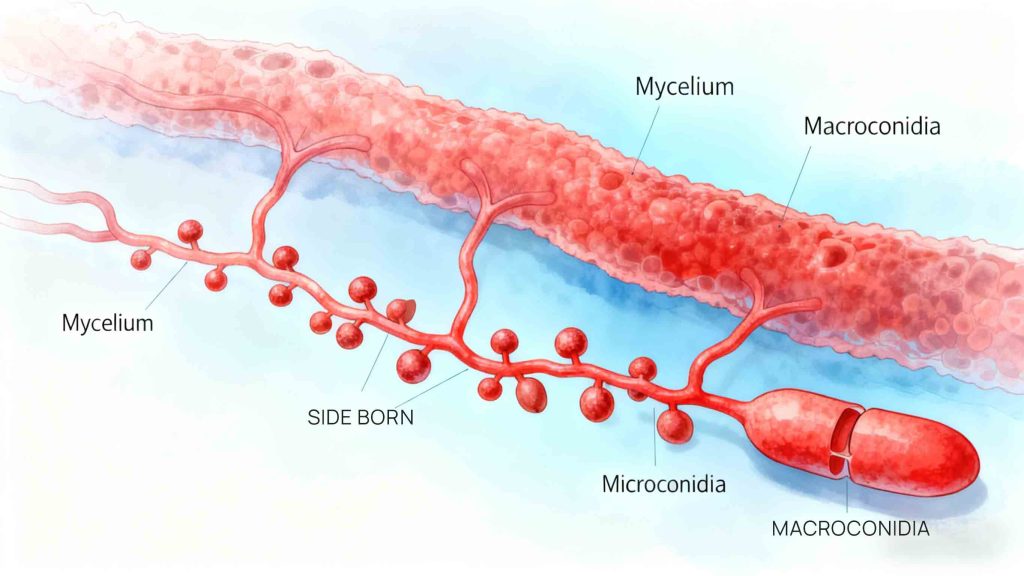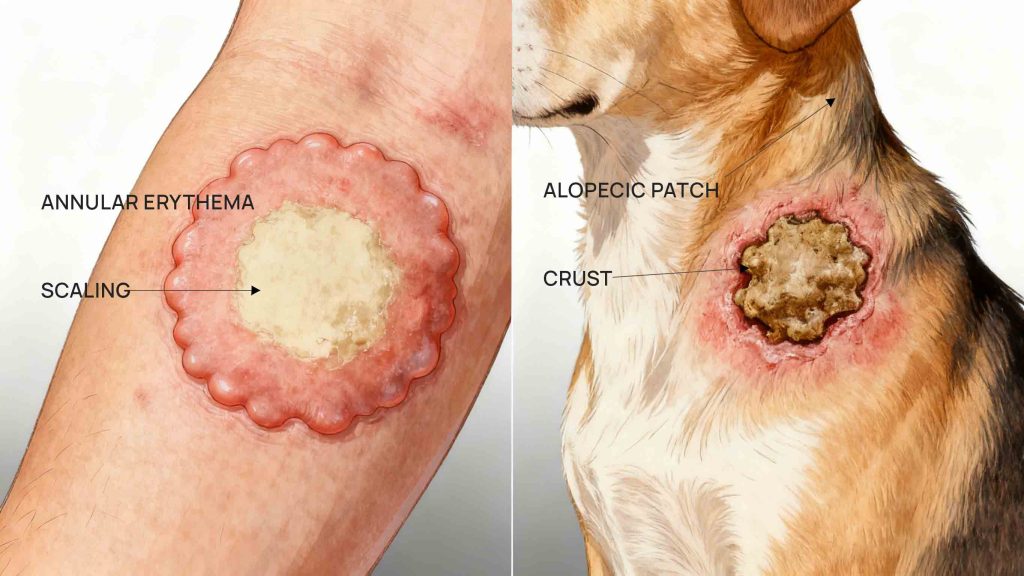Have you ever experienced itching or peeling on your feet after walking barefoot in a damp public bathroom? Or noticed thickened, discolored nails without knowing the cause? These symptoms may likely be caused by a fungus called Trichophyton Rubrum. As one of the primary pathogens responsible for superficial fungal infections of the skin, Trichophyton rubrum is widespread in our daily lives yet remains poorly understood. This article will provide a comprehensive overview of this microorganism, its hazards, and effective prevention methods.
What is Trichophyton Rubrum?
Trichophyton rubrum (T. rubrum)is a prominent member of the Trichophyton genus, specifically infecting human skin, hair, and nails. It is one of the main pathogenic fungi responsible for various types of tinea infections.
This fungus has distinct morphological characteristics:
· Front view: Appears granular or fluffy, ranging in color from white to light yellow.
· Back view: Typically deep red or slightly purple, occasionally brown, orange, or even colorless.
Under suitable culture conditions (e.g., on potato dextrose agar or cornmeal dextrose agar), T. rubrum readily produces pigments, which is the origin of its name.
Environmental resistance of T. rubrum:
· Heat-sensitive: rubrumis heat-sensitive but can tolerate dry conditions and UV light to some extent, Inactivated within 10 minutes at 60°C–70°C.
· Low sensitivity to regular soap and detergents: Requires antifungal cleansers (e.g., ketoconazole wash).
· Susceptible to chemical disinfectants: Common disinfectants (e.g., sodium hypochlorite, glutaraldehyde) can effectively kill it.
· Biofilm formation: Can form biofilms (e.g., on nails or skin surfaces), enhancing its resistance to host immune systems and medications.

Hazards of Trichophyton Rubrum
T.rubrum infections can cause various health issues, significantly impacting patients’ quality of life:
1. Skin Infections (Athlete’s Foot, Ringworm, Jock Itch)
· Symptoms: Itching, scaling, redness; severe cases may involve blisters, erosion, or oozing; chronic infections lead to thickened skin and hyperpigmentation.
· Pathogenic mechanisms: Secretes keratinase to break down skin keratin, damaging the protective barrier; suppresses local immune responses, leading to chronic infections; metabolic byproducts trigger inflammation;
2. Onychomycosis (Nail Fungus)
· Symptoms: Thickened, discolored (yellow/white/black) nails, rough surfaces, brittleness, and nail separation in severe cases. Affects aesthetics and may cause pain or secondary infections.
· Treatment challenges:Dense nail structure hinders drug penetration; fungal biofilms offer protection; long treatment cycles due to delayed diagnosis.
3. Secondary Bacterial Infections
· Risks:Redness, pus formation; may progress to cellulitis or lymphangitis; severe cases can lead to sepsis.
· Causes: Fungal damage to the skin barrier; compromised local immunity; damp environments promote bacterial growth.
4. Chronic Recurrence
· Issues: Prolonged infections, lengthy treatments, potential drug resistance, and reduced quality of life.
· Causes: Re-exposure (e.g., contaminated shoes, household items); biofilm protection; poor patient compliance leading to residual fungal resurgence.
5. Odor Problems
Besides, infections often produce distinct odors due to fungal metabolites:
· Sulfur compounds (e.g., thiols, dimethyl sulfide) similar to the smell of rotten eggs.
· Short-chain fatty acids(e.g., propionic, isovaleric acid) akin to fermented cheese.
· Ammoniafrom nitrogenous waste breakdown.
· Mixed bacterial infections(e.g.,Corynebacterium,Staphylococcus) worsen odors.

Common Environments and Transmission Routes
T.rubrum is a highly contagious fungal pathogen that spreads through direct or indirect contact, thriving in warm, moist environments. Understanding its reservoirs and transmission mechanisms is critical for effective prevention.
1. High-Risk Locations
| Venue Type | Specific Sites | Risk Factors |
| Public damp areas | Bathrooms, locker rooms, pools | Damp floors, barefoot traffic, humid conditions |
| Fitness centers | Gyms, yoga studios | Shared equipment contaminated with sweat; post-exercise sweat |
| Beauty salons | Nail/feet care shops | Inadequate sterilization of tools; communal foot-soaking tubs. |
| Work environments | Mines, military camps | Prolonged use of occlusive boots, limited hygiene |
2. Household Risk Zones
Fungi persist in homes due to inadequate cleaning or damp conditions:
· Footwear: Shoes and socks trap heat/moisture, creating a fungal incubator.
· Bath mats/rugs:Absorbent materials retain moisture and skin flakes.
· Shared items: Towels, slippers, nail clippers, pet bedding.
· Pet-related areas: Scratching posts, pet beds, furniture with animal contact.
3. Transmission Routes
The fungus adheres to host keratin, exploiting skin breaks or scratches. Its spores survive for months (even years) in shed skin flakes, resisting routine cleaners. When the host’s immunity is reduced, it is more susceptible to infection. Cross-infection among family members.
· Direct Contact:
· Skin-to-skin with infected lesions (e.g., athlete’s foot, ringworm).
· Self-inoculation: Scratching infected areas spreads fungi to other body parts.
Indirect Contact:
· Contaminated objects: Shared towels, gym mats, nail tools.
· Polluted surfaces: Pool decks, shower floors with infected skin debris.
Environmental Amplifiers:
· Humidity: Poorly ventilated shoes/clothing promote fungal growth.
· Compromised skin: Cracks from eczema or excessive washing ease fungal entry.
Prevention Measures
Effective prevention of T. rubrum infection requires a multi-pronged approach, combining personal hygiene, environmental control, and scientific disinfection.
1. Personal Protection
· Keep skin dry:
· Thoroughly dry skin folds (toes, groin, armpits);
· Change into breathable, antimicrobial socks after sweating.
· Block transmission:
· Wear sandals in public areas;
· Avoid sharing towels/nail clippers; w
· Ash hands after pet contact.
· Soak contaminated items in disinfectant for 30 minutes before washing.
· Protect skin barrier:
· Use mild acidic cleansers;
· Disinfect minor cuts promptly with iodine.
2. Environmental Disinfection
· Target areas at home:
· Spray/wipe bathrooms and shoe cabinets with silver-ion solution (2–3 times weekly);
· Wash socks/shoes at high heat or soak in disinfectant.
· Disinfection methods:
· Textiles (socks/underwear): Soak in oxygen-based bleach before hot washing.
· Non-washable shoes: Expose to UV light.
· Gym equipment:Wipe with 70% alcohol.
· Nail tools:Sterilize with autoclave or glutaraldehyde;
· Humidity control: Maintain indoor humidity <50%; use dehumidifiers in closets.
3. Special Scenarios
· Travel/sports:
· Disinfect hotel tubs/yoga mats with silver-ion spray;
· Apply antifungal spray inside sneakers.
· Shared living:
· Run empty hot cycles in communal washers;
· Add antibacterial laundry agents.
4. Overlooked Risks
· High-touch surfaces:
· Regularly disinfect phones/keyboards (fungi survive on plastics for weeks).
· Car interiors:
· Clean leather seats with antifungal wipes.
· Gardening:
· Wear gloves; scrub under nails post-activity.
Proactive self-checks are key. Seek dermatological care if symptoms appear to prevent chronic infection.
Scientific Prevention and Efficient Disinfection
Traditional chemical disinfection methods such as chlorine-containing disinfectants or glutaraldehyde or hydrogen peroxide have a high efficiency in reducing T. rubrum, but there are problems such as odor irritation, skin irritation and chemical residues.
The ARGENTUMIX silver ion generator provides an innovative solution for home fungus prevention and control with its safety, environmental protection and high efficiency. Through electrolysis, 1-3ppm silver ion sterilization solution can be produced by tap water. Silver ions (Ag⁺) have broad-spectrum antibacterial properties. They destroy microbial cell membranes, interfere with enzyme activity and DNA replication, cause protein denaturation and cell death, and thus kill bacteria efficiently. They have a significant sterilization effect on T. rubrum.
According to CNAS-certified lab tests (Report No. 2024SP08890R04), a 1 ppm silver ion solution achieves a 99% reduce rate against Trichophyton rubrum (CGMCC 3.629) in 10 minutes (per WS/T 650-2019, 5.2.1). [See Test Report]
Through the simple combination of “a machine + tap water”, ARGENTUMIX can not only effectively reduce pathogenic microorganisms such as T. rubrum, but also reduce the burden of chemical disinfectants and plastic packaging on the environment and human body, truly practicing the healthy living concept of “reducing the burden on the earth”.
Prevention Over Cure.
Pay attention to the details of daily cleaning, take precautions before it happens, and destroy its reproduction conditions – keep dry, maintain the balance of bacterial flora, scientifically disinfect, stay away from fungal infections, and enjoy a healthy and comfortable life.
If you want to know the application of silver ion technology in other scenarios (such as home environment, maternal and child products, and pet disinfection), you can [click here] to get more relevant information.
Note: Silver ion technology (such as ARGENTUMIX) is suitable for daily cleaning and disinfection, and assists in reducing the risk of infection, but it cannot replace drug treatment. If the infection has been confirmed, please follow the doctor’s advice for standardized treatment, and cooperate with environmental disinfection (such as soaking the affected area in contact with objects) to block the spread.
[MORE ABOUT ARGENTUMIX] · [LEARN MORE MICROBE] · [EXPLORE WHERE TO USE]